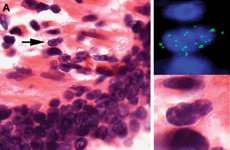A Virus of Interest
XMRV may be a wanted suspect in cases of prostate cancer
By Martha Nolan McKenzie
In early September, a group of scientists, physicians, and epidemiologists gathered at the National Institutes of Health headquarters for the 1st International Workshop on XMRV—a recently discovered retrovirus that has generated considerable controversy due to conflicting findings regarding its possible link with prostate cancer.
While the conference did little to dispel the disparities between the scientific camps finding evidence of XMRV in prostate cancer samples and those finding none, it did establish who a leader in the search for answers would be, Emory. “One thing that became very clear at the conference is that Emory is at the epicenter of XMRV issues,” says Raymond Schinazi, a faculty member in Emory’s Center for AIDS Research and a conference attendee.
This cunning retrovirus may well need such a powerhouse to wrest its secrets. XMRV—or xenotropic murine leukemia virus-related virus—was first identified in prostate tumors in 2006 by researchers at the Cleveland Clinic and University of California at San Francisco. Their study found XMRV present in 40% of prostate tumor samples of one phenotype and in 1.5% of samples of two other phenotypes. However, subsequent studies by other labs, including a study of 800 prostate cancer cases by researchers at Johns Hopkins, found no evidence of the retrovirus. XMRV also has been linked with chronic fatigue syndrome, with similarly conflicting results. A group of CDC researchers couldn’t find XMRV or related viruses in patients with chronic fatigue syndrome (CFS) or healthy controls, but an FDA and NIH team did.
In 2008, in an attempt to get to the bottom of the divergent findings, the CDC enlisted multiple academic centers to study the retrovirus, supplying many with prostate cancer samples from the vast archives of John Petros, an Emory urologist. “I’ve been doing prostate cancer research for 17 years, and I’ve accumulated thousands of specimens from hundreds of patients,” says Petros. “I had never heard of XMRV when the CDC approached me about using some of my samples for its study. But it made me wonder whether I should start looking into it, so I turned to my a colleague who knows everything about retroviruses for advice.”
That colleague was Emory scientist Dennis Liotta, who along with Schinazi developed a major new AIDS drug, Emtriva, that in 2005 earned the university the largest licensing fee awarded at the time. Liotta not only convinced Petros to pick up the study of XMRV, he funded his lab and four others. “That was huge,” says Petros. “You couldn’t get grant support for it at that time because it was too novel for the NIH. Only one grant had been funded, for the University of Utah. Even Robert Silverman [the Cleveland Clinic researcher who originally identified XMRV] had not gotten his grant funded yet.”
At the same time, but independent of the Liotta-funded labs, Schinazi began collaborating with Ila Singh, the University of Utah pathologist who had garnered the only NIH grant. In addition, Abbott Diagnostics contacted Francois Villinger, a pathologist at Emory’s Yerkes National Primate Research Center, to develop a nonhuman primate model of the retrovirus. In all, seven labs at Emory are studying XMRV.
Developing a reliable, repeatable test
The first order of business for Emory researchers was to develop an effective diagnostic test to identify XMRV. “We cannot as a scientific community begin to answer the basic questions of XMRV transmission, frequency in the population, association with disease, etc., until we can effectively test for infection,” says Petros. “If this virus, in fact, promotes prostate cancer and CFS, we need to be able to screen the blood pool and organ donors for it to prevent transmission.”
A test to identify XMRV had to be extremely sensitive since the retrovirus is very hard to detect. “The thinking is that it’s probably sexually transmitted, and people probably get it in their 20s or 30s,” says Petros. “But they don’t develop prostate cancer until their 50s, 60s, or 70s. So by the time you are looking at a man with prostate cancer, the virus is present in very low numbers, making it very hard to find.”
Petros had the good fortune to have on his team a scientist who had expertise in using a neutralizing antibody assay for HIV/AIDS. Jerry Blackwell, a vaccinologist with the Emory Vaccine Center, was able to quickly adapt the HIV/AIDS assay to XMRV.
The immune system produces neutralizing antibodies in response to a virus. Detection of these antibodies indicates that the person is either currently infected with the virus or has been at some point. Though this assay proved very effective at identifying HIV antibodies, Blackwell was not certain it would work for XMRV.
“They are both retroviruses, and they are distantly related, but we didn’t know if the tools that we had for detecting HIV neutralizing antibodies would work for XMRV,” says Blackwell. “It turns out, they did. And since we had most of the expertise and tools that were needed already in place, we were able to develop the XMRV assay very quickly.”
Blackwell initially screened the serum of 40 prostate cancer patients and detected XMRV in 11 of them, or 27%.
To confirm these findings, Petros took prostate tissue samples from a subset and handed them over to Emory clinical chemist Ross Molinaro. Molinaro had worked at the Cleveland Clinic as a graduate student with Silverman when he discovered XMRV, and Molinaro himself developed the initial FISH assay for the virus.
FISH (fluorescent in situ hybridization) works like a lock and key system to identify cells infected with XMRV. “If you think of XMRV as a lock in the tissue, the key we use is a cocktail of fluorescently labeled nucleic acids that match the lock,” says Molinaro. “After the keys find the locks in the tissue, we can then specifically identify the XMRV-infected cells when looking under a microscope.”
Molinaro did find evidence of XMRV in all the serum antibody-positive patients, but detection was difficult. “In XMRV-infected patients, we found that only 1% to 8% of cells within the prostate harbor XMRV nucleic acids,” says Molinaro. “Therefore it may be easy to miss XMRV amongst the large background of other nucleic acids when the viral load is very low.”
Finally, Petros used additional tissue samples from the same subset, extracting their DNA. He performed a PCR (polymerase chain reaction) amplification and was able to detect the viral RNA sequence of XMRV. “We ran three separate blinded tests—albeit on a small number of specimens—in three separate labs on serum and tissue from the same patients, and we got concordant results,” says Petros.
 FISH (fluorescent in situ hybridization) works like a lock and key system to identify cells infected with XMRV. |
Using monkey serum to develop tests for early detection
While Petros and his colleagues were working to develop a human diagnostic test for XMRV, researchers at Yerkes were taking a page from early AIDS investigations, trying to use monkey serum to develop blood tests to detect virus antibodies. “Patients with prostate cancer may be seen many, many years after the XMRV infection takes place,” says Francois Villinger, a pathologist at Yerkes. “If you want to prevent transmission, it’s not very practical to wait until that late stage. You need early detection.”
Toward that aim, Villinger injected three rhesus monkeys with XMRV and followed them for about nine months. He found that all the monkeys developed antibodies to XMRV during the second week of infection, and he identified three proteins that had the greatest response. Villinger then developed three assays to detect the XMRV-specific antibodies. “These assays demonstrated good sensitivity and specificity, so they will facilitate large-scale epidemiologic studies of XMRV infection in humans,” says Villinger.
Villinger, along with Silverman, further found that viral replication peaked on day seven, and he could detect the virus in the blood of the infected animals for only a month. During the early acute infection phase, Villinger found extensive viral replication in epithelial cells of the prostate. However, when he looked at prostate cells nine months later, he could not see any viral replication. He then looked for viral nucleic acids with FISH and found some infected cells. “The virus was still there but not replicating,” says Villinger. “So we know the virus made it to the prostate, but it was controlled there.”
Villinger also found the virus in a number of other organs, including the testes of the male monkeys and the cervix and vagina of the female one. “That’s important because it could indicate that XMRV is sexually transmitted,” says Villinger.
Using AIDS drugs to treat XMRV
Unaware of the XMRV research his colleagues were conducting, Schinazi teamed up with the University of Utah’s Singh to test 45 anti-HIV compounds against XMRV in cell cultures.
They identified four drugs that are effective against XMRV, three of which have already been approved by the FDA to treat AIDS and one of which has been shown to be effective in monkeys with simian immunodeficiency virus, a close cousin to HIV.
The most potent drug against XMRV turned out to be raltegravir, produced by Merck and sold under the commercial name Isentress. The FDA initially approved raltegravir in 2007 only for persons whose HIV infection was resistant to other drugs, but in 2009 its approval was expanded to all HIV cases.
Raltegravir represents a new class of antiretroviral drugs because it inhibits the integrase enzyme, preventing the virus from invading a cell’s DNA. Other drugs against HIV inhibit either the reverse transcriptase enzyme, which copies the virus’ genetic information, or the protease enzyme, which carves up newly produced viral proteins so that viruses can be assembled. However, none of the protease inhibitors inhibited XMRV in culture.
The other three drugs that were effective against XMRV were AZT and tenofovir DF—both reverse transcriptase inhibitors—and another integrase inhibitor.
“We tested the drugs singly and in combination,” says Schinazi. “We believe XMRV will probably mutate and some drug resistance will develop. So it will be very important to use a combination of drugs, in much the same way AIDS is treated.
“My interest now is to understand why some drugs that work against HIV work against XMRV and others don’t,” continues Schinazi. “I’m also interested in discovering the method of transmission. And what happens in the brains of patients who are infected. There is a lot of interesting work yet to be done.”
Indeed, the amount of work that lies ahead was evident at the September NIH conference. “One of the most surprising things at the conference was that not only is there disagreement about whether XMRV is associated with prostate cancer or CFS, but both sides are getting better and better data supporting their positions,” says Petros. “That tells me we still have a long way to go.” EM



